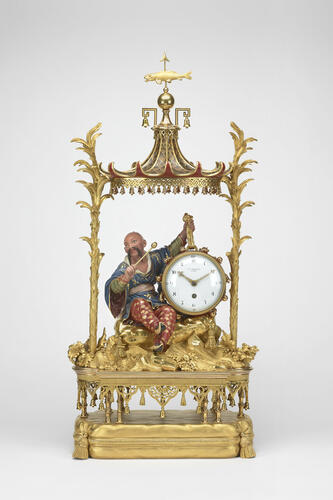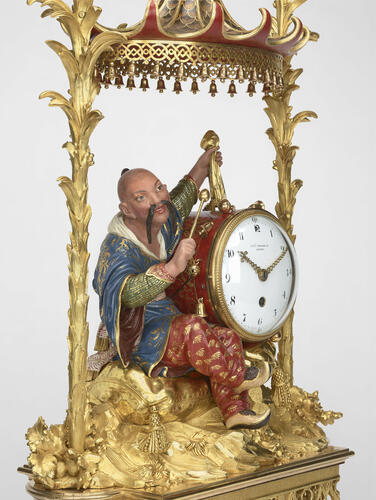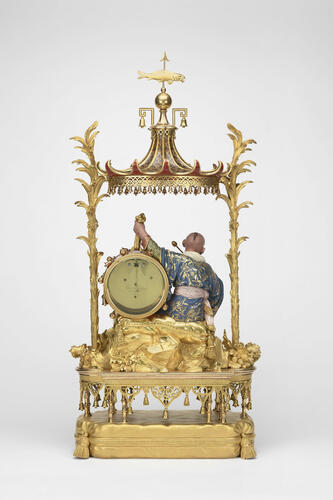-
1 of 253523 objects
Mantel clock 1765-85
Gilded and chased bronze, polychrome lacquer, enamel | 72.5 x 35.5 x 17.2 cm (whole object) | RCIN 2868
-
A Louis XVI mantel timepiece in the form of a chinese drummer boy, under a canopy and seated on a tasselled cushion resting on rocks. He holds, in his raised left hand, the clock cylinder in the shape of a drum, suspended from a ribbon. The canopy, which is hung with bells, is crowned by a finial in the form of a fish pierced by an arrow - like a weathervane. The platform supporting the rocky base rests on clustered vertical bamboo columns which spring from a second, larger tasselled rectangular cushion.
The present mechanism was installed c.1870 by Charles Frosham & Co. It now comprises an eight day timepiece with a fusee movement and recoil escapement. The enamel face, with the 12 hours represented in Roman figures and the minutes at the quarters in arabic numerals, has a pair of gold shaped pierced hands.Provenance
The clock was almost certainly imported from France by Dominic Daguerre, the Parisian marchand-mercier, who in 1787 was employed by the Prince of Wales to assist in the furnishing of Carlton House. At that time it is believed to have had a dial and mechanism by the Parisian maître, Charles-Guillaume Manière. The son of a Parisian master clockmaker, Manière became a maître in 1778 and continued to be active in Paris between 1778-1812. He had premises, from 1781 at rue des Prouvaires, from 1789 at rue des Merciers, from 1806 in the rue Christine and finally from 1810-12 in the rue Bertin-Proirée. He was the principal clockmaker to the marchand-mercier Dominique Daguerre and his successor Martin-Eloi Lignereux who supplied works of art to George IV when Prince of Wales. He also collaborated with ébénistes and bronzeurs, including Pierre-Philippe Thomire and François Rémond, who produced cases for his clocks.
It was placed in the Chinese Room on the Basement Floor and in a description of the clock in William IV's manuscript Clock Inventory of 1835 Benjamin Lewis Vulliamy notes that it formed part 'of a suite of ornaments made expressly for that room'. The decoration of the canopy with fish scale painting was intended to match the canopies over the niches on either side of the chimney piece upon which it stood.
When the furnishings of the Chinese Room were moved in 1811 to the Bow Room on the Principal Floor at Carlton House the clock was heightened by Vulliamy and he added the large tasselled base of gilt bronze, charging £22 16s. and a marble plinth of four steps costing £9 10s. He also supplied a glass dome for 12 guineas which was fitted to purplewood stand covered with crimson velevet priced at £1 11s. 6d.
In 1819 the clock was sent to the Royal Pavilion at Brighton and, during its time there, was recorded in the Drawing Room of the Lord Steward's apartments but without the marble plinth.
The clock was consigned to Windsor following Queen Victoria's decision to sell the Royal Pavilion in 1846. It is item in a 'List of Clocks, Shades Etc packed at the Pavilion Brighton 1846. Delivered by Mr. Tupper to Windsor Castle. 6 Jan 1847' and described as 'A Clock in a Japanned case under a canopy supported by two ormolu Palm Trees and metal Chinese figure on marble step plinth'.
The final change to the mechanism occurred in c.1870 when Charles Frodsham substituted Manière's original dial and movement. -
Creator(s)
(clockmaker (original movement))(clockmaker (movement))(nationality)Acquirer(s)
-
Medium and techniques
Gilded and chased bronze, polychrome lacquer, enamel
Measurements
72.5 x 35.5 x 17.2 cm (whole object)
Object type(s)
Alternative title(s)
Drummer Boy clock


